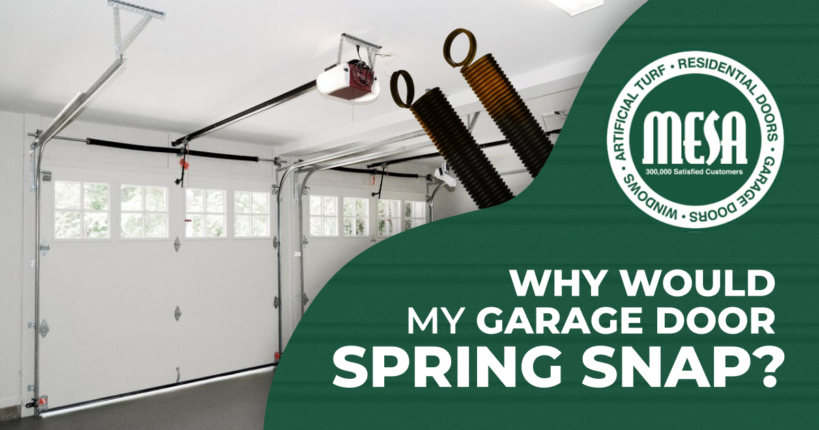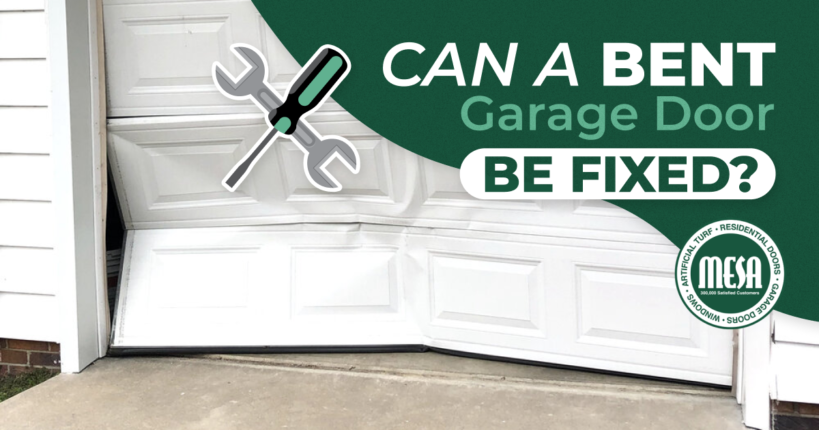Why Would My Garage Door Spring Snap?
There’s never a good time for a garage door spring to snap. You may arrive home after a long day at work or in a hurry to leave, and your garage door won’t work. Maybe you’re lucky enough to hear the sudden bang of a spring failing. Once a garage door spring has snapped, the only option is to replace it; this is a common repair since torsion and extension springs have a limited lifespan. Here, we’ll look at the reasons for garage door spring repair.
Reasons Garage Door Springs Snap
Extension springs last seven to 12 years on average, and torsion springs can last up to 15 years. Their lifespan depends on how many cycles they’re rated for. How frequently you operate the garage door and environmental factors can impact a garage door spring’s lifecycle.
If not replaced beforehand, the spring will fail at the end of its life, leaving a gap, loose cable, or a garage door that’s crooked, struggles to move up or down, or falls to the ground. These are the most common reasons this can happen:
- Wear and Tear: Garage door springs usually last about 10,000 cycles (one cycle is the garage door opening and closing). Higher-end springs can last for 20,000 cycles or more. Homeowners typically use their garage doors at least twice a day. The springs will eventually wear out due to frequent motion and the weight of the door, usually showing signs of damage before they break.
- Excessive Tension: Too much tension can weaken garage door springs. Made of tempered steel, they will break under too much stress. Regular maintenance can reduce the strain on the springs; otherwise, they are at risk of failing prematurely and you’ll need garage door spring repair.
- Extreme Temperatures: Garage door springs are more susceptible to breaking during a heat wave or cold spell. Insulating your garage can mitigate the effects of dramatic fluctuations in temperature. Installing weatherstripping also provides some protection. Otherwise, rapid expansion and contraction of metal when temperatures change can cause them to become brittle and fail.
- Jammed Door: Garage door tracks can fill with dirt, debris, and grime. Dirty tracks can damage rollers, causing the door to jam and putting excess stress on the springs. The extra force can cause a spring to snap abruptly or speed up wear and tear so it fails prematurely.
- Rust and Corrosion: When rust forms on a garage door spring, it increases the amount of friction as the spring moves, shortening its lifespan. Corrosion physically weakens the coils, so they fail sooner than expected.
- Poor Installation: If the spring is the wrong size or installed improperly, it’s unlikely to handle normal use without wearing out faster. The spring can suddenly fail. To avoid such a situation, avoid DIY spring replacement and hire a certified technician with experience replacing garage door springs in residential settings.
- Lack of Maintenance: Lubricating the spring with a silicone-based or white lithium grease can reduce friction, slow down corrosion, and increase life expectancy and the time between garage door spring repairs. Springs should be lubricated three or four times a year. Another helpful tip is to reduce the spring’s exposure to moisture.
Also, make sure to follow other garage door maintenance recommendations. These include checking for signs of damage or wear and testing the door’s balance. To do this, pull the emergency release cord to disconnect the garage door opener and lift the door halfway. When you let go, it should hold it still. However, if the door falls on its own, the springs should be adjusted or replaced.
Contact Us for Professional Garage Door Spring Repair
Mesa Garage Doors safely, quickly, and effectively replace garage door springs in homes across Southern California. We can also fix garage door openers, cables, tracks, rollers, and panels. Our operators are available 24/7 in case of an emergency. To request garage door spring repair or any other service we offer, call (714) 559-3696 today.




